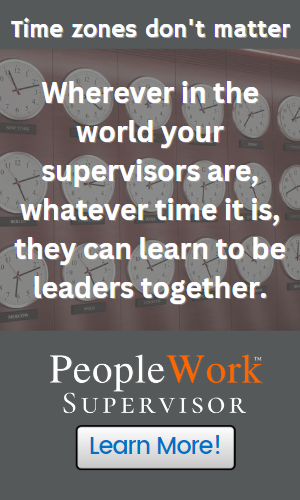Safety’s Top 3 Challenges
In preparing a virtual presentation for the members of an electrical utilities association, I asked the organizing committee to survey their members with one question: what is the biggest issue you would like to overcome in safety in the next 12 months?
The responses addressed issues in three key areas of their individual operations.

The three areas are as follows:
- Employee Participation in the Safety Program.
- Supervisor Buy-in to the Safety Program.
- Effective Training Techniques.
Let’s address each of these individually.
Employee Participation in the Safety Program.
In the 2016 release of my book, PeopleWork: The Human Touch in Workplace Safety, I wrote:
So much time, effort, and money is wasted on enforcement tactics because so little time is spent on encouraging employees to buy into safety. The energy spent on enforcement could be better spent building teamwork, morale, and camaraderie.
As it plays out in the real world, a team that has adopted safety as a personal value is better equipped to make the kinds of decisions on the job to ensure safety. Instead of mere compliance with procedures, programming, and production, a safety-oriented crew draws from a deep well of mutual caring and connection. (Page 51).

Simply put, we don’t need more rules enforcement, we need more people to buy-in to what we are trying to do in safety. That is a communications and marketing issue. And it takes a very different set of skills to achieve it.
Employee participation in safety has to become one of the most important components of an effective safety program. We need to bring our employees together to rally around safety as a movement or cause, not as a compliance program.
Supervisor Buy-in to the Safety Program.
Employees do what supervisors do. Period. So, it stands to reason that if supervisors buy-in to safety, so will the people they supervise.
No one has more of an influence on frontline employees, safety performance, production, morale, motivation, communications, or coaching than the supervisor. And when it comes to participating in safety, if the supervisor demonstrates their own commitment to safety, the employee will do as their supervisor does.
In order to create supervisor buy-in, companies must ensure that supervisors acquire the tools and techniques to keep their teams from slipping into complacency. They also need to get access to techniques and strategies for self-motivation and team motivation, as well as strategies for creating employee buy-in to the safety program.
Eighty percent of a supervisor’s day is spent coaching, communicating, managing, leading, and dealing with people. So, companies must set that supervisor up to win, to be effective. That’s because a frontline supervisor needs to embody the traits, skills, and image that the organization would like to project to their employees.
Effective Training Techniques.
To describe effective training techniques, let's take the example of a night out with friends at a restaurant. You’re seated at the restaurant table and you hold the menu in your hands. You want to try everything on the menu, so you must decide one of two things:
- order everything on the menu all at once and eat as much as you can over eight hours, or ...
- order one or two dishes and enjoy it, savor it, digest it while having and enjoyable experience discussing your meal with your friends.

To eat everything on the menu in one sitting is impossible. You won't enjoy a good portion of it. You wouldn’t be able to recall most of it. You certainly cannot digest all of it. And you will most likely not retain the biggest part of it (if you get my meaning there).
And yet, we are quick to sit our supervisors down for a full day of training; to throw eight hours of material at them. Then, we expect them to be able to recall everything they learned, to digest it all, and to retain it all. Impossible.
When you have too much information coming at you at once, you will not enjoy the experience as it adds pressure knowing that when needed, you are going to forget crucial pieces of information.
Here is a more effective way to train.
Consider taking that same eight hours of learning and split it up into eight weekly segments of one hour of learning. Then, follow up each weekly learning module with a one-hour group discussion about the material. You could add in an additional half-hour mentoring component later in the week - something that reinforces the theme and learning for the week.

That’s exactly how the Safety Communications & Coaching for Supervisors Program was designed to be delivered. Focus on one subject or topic for the week; and become effective at that one thing before moving on to the next module or subject.
Effective training isn’t about lots of information at a time. Effective training is about learning a little at a time, followed by clarity, followed by reinforcement, followed by mastery.
If you don’t master it, it wasn’t effective training.
So, what are the Top 3 Safety Challenges that you and your organization want to address in the next year?
--
Kevin Burns is the President/CEO of KevBurns Learning. Kevin works with smart, caring companies to energize safety culture, build teamwork, and improve employee participation in safety.
In 2020, BookAuthority.org named PeopleWork #7 of The Top 44 Workplace Safety Books of All Time. Buy yourself a copy of PeopleWork: The Human Touch in Workplace Safety and give another as a gift to a colleague.
Subscribe to Kevin’s Blog.



